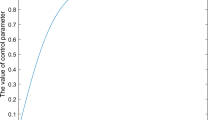Abstract
Evolutionary algorithms have long been quite successfully applied to solve multi-objective optimization problems. However, theoretical analysis of multi-objective evolutionary algorithms (MOEAs) is mainly restricted to the simple evolutionary multi-objective optimizer (SEMO). The Pareto archived evolution strategy (PAES) is a simple but important multi-objective evolutionary algorithm which is come from the study of telecommunication problems, and it has been successfully applied to many optimization problems, such as image processing and signal processing. In this paper, we make a first step toward studying the rigorous running time analysis for PAES. We show that the PAES outperforms the SEMO on function PATH when the PAES uses a simple mutation operator. However, it can not find the whole Pareto front with overwhelming probability on the well-studied function LOTZ. Additional experiments show that the experimental results are in agreement with the theoretical results.





Similar content being viewed by others
References
Al-Ayyoub M, Alzu’bi S, Jararweh Y, Shehab MA, Gupta BB (2016) Accelerating 3d medical volume segmentation using GPUs. Multimed Tools App 2016:1–20
Brockhoff D, Bader J, Thiele L, Zitzler E (2013) Directed multiobjective optimization based on the hypervolume indicator. J Multi-Crit Decis Anal 20(5-6):291–317
Corne DW, Jerram NR, Knowles JD, Oates MJ (2001) PESA-II: Region-based selection in evolutionary multi-objective optimization. In: Proceedings of GECCO, vol 2001, pp 283–290
Deb K, Pratap A, Agarwal S, Meyarian T (2002) A fast and elitist multi-objective genetic algorithm: PESA-II. IEEE Trans Evol Comput 2(6):182–197
Friedrich T, Neumann F, Thyssen C (2013) Multiplicative approximations, optimal hypervolume distributions, and the choice of the reference point. Evol Comput 23(1):131–159
Giel O (2003) Runtime analysis for a simple multiobjective evolutionary algorithm. Tech-Report Department of Computer Science, University of Dortmund, Germany
Giel O, Wegener I (2003) Evolutionary algorithms and the maximum matching problem. In: Proceedings of 20th STACS, LNCS, vol 2607, pp 415–426
Gupta BB, Agrawal DP, Yamaguchi S (2016) Handbook of research on modern cryptographic solutions for computer and cyber security. IGI global
Gutjahr WJ, Sebastiani G (2008) Runtime analysis of ant colony optimization with best-so-far reinforcement. Methodol Comput Appl Probab 10(3):409–433
Hanne T (2001) Global multiobjective optimization with evolutionary algorithms: Selection mechanisms and mutation control. Evolutionary Multi-Criterion Optimization Lecture Notes in Computer Science 1993:197–212
Jararweh Y, Al-Ayyoub M, Fakirah M, Alawneh L, Gupta BB (2017) Improving the performance of the needleman-wunsch algorithm using parallelization and vectorization techniques. Multimed Tools App 2017(3):1–17
Knowles JD, Corne DW (2000) M-PAES: a memetic algorithm for multiobjective optimization. In: Congres on evolutionary computation (CEC 00), pp 325–332
Knowles JD, Corne DW (1999) The Pareto archived evolution strategy: A new baseline algorithm for Pareto multiobjective optimization. In: Congres on evolutionary computation (CEC 99), vol 1. IEEE Press, Piscatawy, NJ, pp 98–105
Kumar R, Banerjee N (2006) Analysis of a multiobjective evolutionary algorithm on the 0 − 1 knapsack problem. Theor Comput Sci 358:104–120
Laumanns M, Thiele L, Zitzler E, Deb K (2002) Archiving with guaranteed convergence and diversity in multi-objective optimization. In: Proceedings of GECCO, vol 2002, pp 439–447
Laumanns M, Thiele L, Zitzler E (2004) Runtime analysis of evolutionary algorithms on pseudo-Boolean functions. IEEE Trans Evol Comput 8(2):170–182
Laumanns M, Thiele L, Zitzler E (2004) Runtime analysis of multiobjective evolutionary algorithms on pseudo-Boolean functions. IEEE Trans Evol Comput 2 (8):170–182
Laumanns M, Thiele L, Zitzler E (2004) Runtime analysis of evolutionary algorithms on a simplified multiobjective knapsack problem. Nat Comput 3:37–51
Neumann F, Wegener I (2007) Randomized local search, evolutionary algorithms, and the minimum spanning tree problem. Theor Comput Sci 378:32–40
Neumann F, Reichel J, Skutella M (2011) Computing minimum cuts by randomized search heuristics. Algorithmica 59:323–342
Nguyen Q, Sutton A, Neumann F (2015) Population size matters: rigorous runtime results for maximizing the hypervolume indicator. Theor Comput Sci 561:24–36
Qian C, Yu Y, Zhou ZH (2013) An analysis on recombination in multiobjective evolutionary optimization. Artif Intell 204:99–119
Rhazali Y, Hadi Y, Mouloudi A (2016) A Based-Rule method to transform CIM to PIM into MDA. International Journal of Cloud Applications and Computing (IJCAC) 6.2:11–24
Scharnow J, Tinnefeld K, Wegener I (2002) Fitness landscapes based on sorting and shortest paths problems. In: LNCS, vol 2439, pp 54–63
Sudholt D (2006) On the analysis of the (1 + 1) memetic algorithm. In: Proceedings of GECCO, vol 2006, pp 493–500
Xia X, Zhou Y (2018) On the effectiveness of immune inspired mutation operators in some discrete optimization problems. Inform Sciences 426:87–100
Xia X, Zhou Y, Lai X (2015) On the analysis of the (1 + 1) evolutionary algorithm for the maximum leaf spanning tree problem. Int J Comput Math 92(10):2023–2035
Zhang Q, Li H (2007) MOEA/D: a multi-objective evolutionary algorithm based on decomposition. IEEE Trans Evol Comput 11(6):712–731
Zhou Y (2009) Runtime analysis of an ant colony optimization algorithm for TSP instance. IEEE Trans Evol Comput 13(5):1083–1092
Zitzler E, Laumanns M, Thiele L (2001) SPEA2: Improving the strength pareto evolutionary algorithm for multiobjective optimization. In: Fifth conference on evolutionary methods for design, optimization and control with applications to industrial problems, pp 95–100
Acknowledgements
This work was supported by the National Natural Science Foundation of China (61773410, 61703183), the Natural Science Foundation of Jiangxi Province of China (20151BAB217008) and the Foundation for Distinguished Young Talents in Higher Education of Guangdong (2015KQNCX086).
Author information
Authors and Affiliations
Corresponding author
Rights and permissions
About this article
Cite this article
Peng, X., Xia, X., Liao, W. et al. Running time analysis of the Pareto archived evolution strategy on pseudo-Boolean functions. Multimed Tools Appl 77, 11203–11217 (2018). https://doi.org/10.1007/s11042-017-5466-3
Received:
Revised:
Accepted:
Published:
Issue Date:
DOI: https://doi.org/10.1007/s11042-017-5466-3




